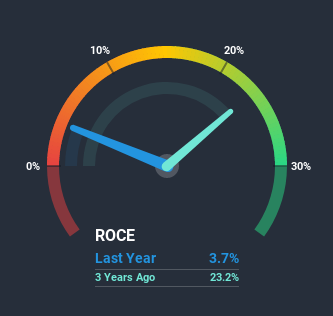Will Domain Holdings Australia (ASX:DHG) Multiply In Value Going Forward?

If we want to find a potential multi-bagger, often there are underlying trends that can provide clues. Ideally, a business will show two trends; firstly a growing return on capital employed (ROCE) and secondly, an increasing amount of capital employed. Put simply, these types of businesses are compounding machines, meaning they are continually reinvesting their earnings at ever-higher rates of return. In light of that, when we looked at Domain Holdings Australia (ASX:DHG) and its ROCE trend, we weren't exactly thrilled.
What is Return On Capital Employed (ROCE)?
For those who don't know, ROCE is a measure of a company's yearly pre-tax profit (its return), relative to the capital employed in the business. The formula for this calculation on Domain Holdings Australia is:
Return on Capital Employed = Earnings Before Interest and Tax (EBIT) ÷ (Total Assets - Current Liabilities)
0.037 = AU$44m ÷ (AU$1.3b - AU$76m) (Based on the trailing twelve months to June 2020).
So, Domain Holdings Australia has an ROCE of 3.7%. In absolute terms, that's a low return and it also under-performs the Interactive Media and Services industry average of 12%.
See our latest analysis for Domain Holdings Australia
Above you can see how the current ROCE for Domain Holdings Australia compares to its prior returns on capital, but there's only so much you can tell from the past. If you'd like, you can check out the forecasts from the analysts covering Domain Holdings Australia here for free.
What The Trend Of ROCE Can Tell Us
On the surface, the trend of ROCE at Domain Holdings Australia doesn't inspire confidence. Around three years ago the returns on capital were 23%, but since then they've fallen to 3.7%. And considering revenue has dropped while employing more capital, we'd be cautious. If this were to continue, you might be looking at a company that is trying to reinvest for growth but is actually losing market share since sales haven't increased.
On a side note, Domain Holdings Australia has done well to pay down its current liabilities to 6.0% of total assets. That could partly explain why the ROCE has dropped. Effectively this means their suppliers or short-term creditors are funding less of the business, which reduces some elements of risk. Since the business is basically funding more of its operations with it's own money, you could argue this has made the business less efficient at generating ROCE.
The Bottom Line On Domain Holdings Australia's ROCE
In summary, we're somewhat concerned by Domain Holdings Australia's diminishing returns on increasing amounts of capital. However the stock has delivered a 24% return to shareholders over the last year, so investors might be expecting the trends to turn around. Regardless, we don't feel to comfortable with the fundamentals so we'd be steering clear of this stock for now.
On a separate note, we've found 1 warning sign for Domain Holdings Australia you'll probably want to know about.
For those who like to invest in solid companies, check out this free list of companies with solid balance sheets and high returns on equity.
This article by Simply Wall St is general in nature. It does not constitute a recommendation to buy or sell any stock, and does not take account of your objectives, or your financial situation. We aim to bring you long-term focused analysis driven by fundamental data. Note that our analysis may not factor in the latest price-sensitive company announcements or qualitative material. Simply Wall St has no position in any stocks mentioned.
Have feedback on this article? Concerned about the content? Get in touch with us directly. Alternatively, email editorial-team@simplywallst.com.



